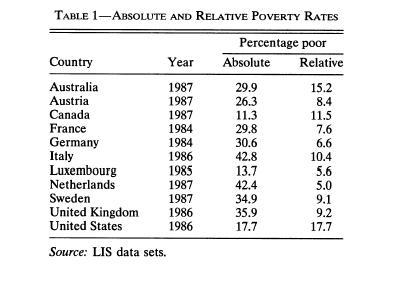 Tom Smith found a source--McKinley Blackburn, AER 1995-- that did the calculations
to compare poverty rates across nations, a subject I posted on February 16. The results in
Table 1 show that Canada and Luxemburg have by far the lowest poverty, then the U.S.,
then a big gap before we get to Austria, Australia, and France. Blackburn explicitly
avoids saying which measure is better, absolute or relative, because he was space
constrained, but I still can't see how the relative measure is any good.
Tom Smith found a source--McKinley Blackburn, AER 1995-- that did the calculations
to compare poverty rates across nations, a subject I posted on February 16. The results in
Table 1 show that Canada and Luxemburg have by far the lowest poverty, then the U.S.,
then a big gap before we get to Austria, Australia, and France. Blackburn explicitly
avoids saying which measure is better, absolute or relative, because he was space
constrained, but I still can't see how the relative measure is any good.The relative measure defines "poverty" as to be earning less than 50% of the median income in the country. Thus, if you had incomes spread evenly across all values, relative poverty would be 25% in the country. That would be the case, if for example, people earned from $0 to $100,000 per year, with a median of $50,000, and 25% of them earned between $0 and $25,000. If, however, almost all of the below-median people were clustered around $30,000, there would be no poverty-- even if almost all of the above- median people were clustered around $100,000. Thus, relative poverty is not even a good measure of the inequality of income distribution.
I would predict that using relative poverty on county level data, we would find that the wealthier counties would be the ones with higher relative poverty. The reason: A wealthy suburb has a high "entry fee" income, but on the upside it will also include the very richest people in the country, who are far wealthier than "ordinarily rich" people. Thus, the suburb might have a minimum income of $100,000 and a median income of $400,000, with, say, 20% of the people in the $100,000-$200,000 range. Such a suburb would show up as having higher poverty than the United States as a whole.
Reference for Table: McKinley L. Blackburn, "International Comparisons of Poverty," The American Economic Review, Vol. 84, No. 2, Papers and Proceedings of the Hundred and Sixth Annual Meeting of the American Economic Association. (May, 1994), pp. 371-374 http://links.jstor.org/sici?sici=0002-8282%28199405%2984%3A2%3C371%3AICOP%3E2.0.CO%3B2-W ($).
Later that day. I should have mentioned the Battery Scientist's argument for why using relative poverty is likely to make the U.S. look like it has lots of poverty: that the measure will generally make large countries have more poverty than small countries. That is true because we'd expect a large country to have more variance in wealth than a small country. Denmark and Greece may each have fairly equal income distributions, but if you combined them into one country, that country would have radical income inequality and high poverty by the relative poverty measure, because Greece is a lot poorer than Denmark. So with Mississippi and Massachusetts. If you knock the U.S. on some kind of equality statistic, and praising Europe, please count Europe as one country! Otherwise, just pick one U.S. state for the comparison with Sweden or wherever.
[in full at 04.02.21a.htm . Erasmusen@yahoo.com. ]
To return to Eric Rasmusen's weblog, click http://php.indiana.edu/~erasmuse/w/0.rasmusen.htm.